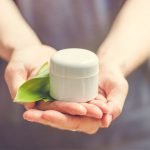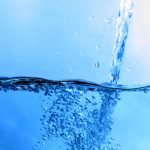Estrogen-Deficient Skin: Benefits from Topical Estrogens & Phytoestrogens
KATIE STROBE, ND
Menopause is a pivotal time in a woman’s life that is characterized by decreased estrogen levels due to declining ovarian function. Biological aging accelerates throughout the body’s tissues and is particularly noticeable on the skin, which loses structural integrity. The alterations to the skin include decreased vascularity, fibroblast production, collagen, and elastin, and increased matrix metalloproteinases (MMPs). These changes result in increased atrophy, wrinkling, dryness, and impaired wound healing. Research has demonstrated that oral estradiol can prevent and reverse these changes. Yet not every woman is a candidate for this type of therapy. The purpose of this article is to provide an overview of estrogen’s role in the skin and to explore cutaneous interventions that work through the estrogen receptors. Specifically, this includes estriol and the phytoestrogens: genistein, daidzein, equol, and resveratrol.
Aging & Estrogen-Deficient Skin
With advances in research and medicine, women are living longer; however, the age of menopause remains stable at around 51 years old. Therefore, women are spending a significant amount of their lives in estrogen deficiency. Estrogens are steroidal hormones mainly produced by the ovaries in 3 main forms: estrone (E1), estradiol (E2), and estriol (E3). Estradiol makes up 80% of the estrogen in a women’s body during her reproductive years. There are 2 types of estrogen receptors: ERa and ERb. Estradiol binds equally to ERa and ERb, estrone preferentially binds to ERa, whereas estriol has an affinity for ERb.1
As skin ages, it becomes more susceptible to trauma, which can lead to increased bruising and lacerations. With a growing geriatric population, the burden of wound healing has increased. Estrogen has been shown to increase transforming growth factor-beta (TGF-b) levels, which enhances the quality and rate of wound healing.2 In one study, men and women with punch biopsy wounds were treated with topical estrogen or a control for 7 days.3 Compared to the control group, both men and women in the estrogen group showed higher collagen and an 18% decrease in the wound size. These findings illustrate that topical estrogen supports wound healing in both elderly women and men.3
Estrogen’s Regulation of Skin Structure
The role played by estrogen in the skin includes maintaining thickness, regulating moisture, supporting elasticity, and facilitating would healing.4 Some of the key structural components regulated by estrogen are collagen, elastin, water, and extracellular matrixes. Numerous studies indicate that in estrogen-deficient skin (EDS), these components are decreased.5,6
1) Collagen
A hallmark of aging skin is the accumulation of collagen breakdown products, which results in decreased mechanical tension and, as a result, wrinkle formation. Collagen gives the dermis its structural and mechanical integrity, and it makes up 70-80% of skin’s dry weight.7 The predominant form of collagen in the skin is collagen type I (80%); collagen type III makes up the remainder.8 There is a strong correlation between menopausal EDS and decreased collagen levels.8-13 In the first 5 years after menopause, as much as 30% of type I and type III collagen is lost.5 Moreover, with each postmenopausal year, total collagen decreases by 2.1% for 15 years.5 Oral, subcutaneous, and topical administration of estrogen have all been demonstrated to prevent collagen decline and to increase collagen content in the skin.8,9,14-16
2) Elastin
Elastin fibers are interwoven with collagen in the dermis to facilitate recoiling after transient stretching of the skin and to prevent overstretching. In EDS, structural changes to elastin fibers accelerate the loss of skin elasticity, which contributes to wrinkle formation.17 Clinical studies indicate increased elasticity with topical application of estrogen.14,18–20
3) Water
The content of water in the skin is dependent on evaporation rate and dermal hydration.9 Glycosaminoglycans (GAGs) in the dermis contain large amounts of water and are thus critical for hydration of the skin.21 Another major player is hyaluronic acid (HA), which supports moisture content and also helps spread soluble factors and nutrients in the dermis.22 Estrogen stimulates an increase in GAGs and HA, which leads to higher water content in the skin. Estrogen induces epidermal growth factor expression in keratinocytes, which increases HA expression.21,23 Additionally, estrogen supports water content in the skin through the promotion of sebum production in sebocytes, which results in moisture retention.3 Clinical studies demonstrate that topical estradiol and estriol can increase GAGs and HA, thereby increasing the water content of the skin.24,25
4) Extracellular Matrix & Oxidative Damage
The extracellular matrix (ECM) is composed of water, polysaccharides, and structural proteins, and it serves as a structural support for cells. In addition, the ECM provides a transport system for waste products and nutrients, and it lubricates cells.26,27 Reactive oxygen species (ROS) such as hydrogen peroxide can cause significant damage to the ECM.28 ROS can activate pathways for producing matrix metalloproteinases (MMPs), which are enzymes that break down collagen. An altered oxidative state is found in estrogen deficiency and can cause decreased collagen production.29 In a human fibroblast cell culture study, estrogen was shown to increase survival of keratinocytes and fibroblasts exposed to H202.29 Experimental data indicate that estrogen can protect the skin from oxidative damage.10
Topical Therapies Targeting Estrogen Receptors
Estriol
As mentioned above, estriol (E3) is one of 3 main forms of estrogen. During pregnancy, estriol is produced by the placenta in high amounts, but in much lower quantities the rest of the time. Emerging evidence demonstrates that estriol has immunomodulatory properties and could thus be helpful in autoimmune diseases such as rheumatoid arthritis, thyroiditis, psoriasis, uveitis, and multiple sclerosis.30 Currently, estriol is most widely known for its topical uses in gynecology to manage vaginal atrophy, and urinary tract infections in postmenopausal women.31,32 Now, dermatologists are looking at the topical use of estriol for its ability to support skin health, particularly in postmenopausal women. One of the allures of estriol is that it is a weak estrogen and believed to provide protection for menopausal symptoms without increasing the risks correlated with stronger estrogens.33
In a clinical trial, Schmidt et al examined whether topical estradiol and estriol could reverse changes in aging skin.14 Perimenopausal and postmenopausal women applied either 0.01% estradiol or a 0.03% estriol cream to the face and neck for 6 months. To evaluate possible systemic changes in hormone levels, serum levels of estradiol, follicle-stimulating hormone, and prolactin were checked monthly. Skin was checked before and after treatment via corneometry and skin profilometry for parameters such as skin elasticity, skin moisture, wrinkling, and pore size. In 10 cases, biopsies were included, and collagen types were analyzed via immunohistochemistry. The results showed that serum levels of estradiol were slightly increased in the estradiol group but not in the estriol group. Both treated groups showed a significant decrease in wrinkling, increased collagen fibers, improved moisture, and vascularization. Overall, the study showed that “both estrogen compounds were found to be highly effective in preventing or treating skin aging in perimenopausal women, clinically, by measurement data, and by an increase in collagen Type lll.”14
Topical Therapies Targeting Estrogen Receptors
Phytoestrogens
Phytoestrogens are polyphenolic plant compounds that exhibit estrogen-like effects in animals. They are structurally similar to 17b-estradiol and they weakly bind to estrogen receptors. There is growing interest in utilizing phytoestrogens to fight skin aging, since they have been shown to have antioxidant and anti-inflammatory properties, especially in postmenopausal women.25,34-36 Additionally, phytoestrogens have been demonstrated to increase skin collagen levels, decrease collagen degradation, and increase hyaluronic acid and moisture in the skin.37-40 Phytoestrogens have 4 phenolic classifications: stilbene, coumestan, lignan, and isoflavone.41 The phytoestrogens we will take a closer look at are genistein, daidzein, equol, and resveratrol.
In a controlled clinical trial, 234 women applied an isoflavone cream to their face, neck, and 1 arm (with the other arm serving as the control) for 12 weeks.4 Skin roughness and wrinkles improved by 39.2% and 22% respectively. Facial wrinkles decreased by 22%, and skin looseness decreased by 24%.
1) Genistein
Genistein is the main isoflavone found in soybeans and fermented soy foods. Animal research has demonstrated interesting results for genistein with regard to skin cancer prevention, skin elasticity, photo-aging, skin dryness, and wrinkles.38 One of the mechanisms by which genistein reduced skin aging in this study was by inducing the expression of VGEF and TGF-ß, which has the effect of increasing the thickness of skin collagen.38 Additionally, genistein inhibits collagen degradation through the regulation of MMPs.37 Genistein also exhibits antioxidant properties and has been shown to reduce ROS by regulating glutathione levels; this results in increased cell proliferation and viability rates.42 Multiple clinical trials, in which topical 4% genistein cream was applied to the faces of postmenopausal women, showed significant improvement; in some cases, genistein performed better than estradiol.43
2) Daidzein
Like genistein, daidzein is a phytoestrogen isoflavone that is found mainly in soy foods. It has been shown to play a role in prevention and treatment of osteoporosis, cardiovascular disease, diabetes, cancer, and skin diseases.
In cultured dermal fibroblasts, daidzein was shown in a dose-dependent manner to stimulate estrogen receptor transcription, with up to a 2.5-fold induction compared to the control. Daidzein also increased the expression of collagen type IV, fibillin-1, and elastin in dermal fibroblasts.36 Daidzein’s pharmacological effects are believed to be due to its various metabolites, such as trihydroxy isoflavone and equol.36
3) Equol
Equol is found naturally in white cabbage and is converted from daidzein via bacterial metabolism in the gut. Equol has been shown to selectively binds to ERb, which is abundant in fibroblasts in the dermis and keratinocytes in the epidermis.36 This binding to ERb initiates the transcription of antioxidant enzymes such as glutathione peroxidase and superoxide dismutase.36 In a human dermal model, equol was shown to stimulate the production of type I and type III collagen and to downregulate MMPs (which degrade collagen).44
4) Resveratrol
Resveratrol, a powerful antioxidant polyphenol found in grapes, has grabbed the attention of researchers investigating a range of its anti-aging properties.45 Recent studies demonstrate its protective role in the skin through many mechanisms. In human gene expression assays, resveratrol increased the expression of a variety of anti-aging genes, including sirtuin 1 activator, proliferating cell nuclear factor, nerve growth factor, collagen, elastin, and superoxide dismutase.40 Additionally, resveratrol downregulated dermal aging genes, such as calcium-binding proteins and MMPs.40 Resveratrol has been shown to act upon cell signaling pathways connected to UV-mediated photoaging. Specifically, in keratinocytes exposed to UVA radiation, resveratrol lowered ROS in a dose-dependent manner compared to the control.43
Summary
The decline of estrogen levels in the skin is a key endogenous cause of skin aging in women. Traditionally, women have used oral estradiol to reduce menopausal symptoms such as wrinkles. However, there can be side effects of this therapy, and it is not indicated in all women. Thus, topical application of estrogen continues to gain recognition as a practical, convenient, and effective means of administration. The use of locally applied low concentrations of estriol, a weak estrogen, has been demonstrated to support skin thickness, increase hydration, improve elasticity, and enhance wound healing with few side effects. Activation of estrogen receptors by phytoestrogens is another method to improve skin health that is gaining recognition. There is still research to be done; however, in the meantime, targeting cutaneous estrogen receptors with topical estriol and phytoestrogens to support skin health in postmenopausal women shows promise.
References:
- Zhu BT, Han GZ, Shim JY, et al. Quantitative structure-activity relationship of various endogenous estrogen metabolites for human estrogen receptor alpha and beta subtypes: Insights into the structural determinants favoring a differential subtype binding. Endocrinology. 2006;147(9):4132-4150.
- El Mohtadi M, Whitehead K, Dempsey-Hibbert N, et al. Estrogen deficiency – a central paradigm in age-related impaired healing? EXCLI J. 2021;20:99-116.
- Ashcroft G, Dodsworth J, Boxtel E, et al. Estrogen accelerates cutaneous wound healing associated with an increase in TGF-β1 levels. Nat Med. 1997;3(11):1209-1215.
- Rzepecki AK, Murase JE, Juran R, et al. Estrogen-deficient skin: The role of topical therapy. Int J Womens Dermatol. 2019;5(2):85-90.
- Thornton M. Estrogens and aging skin. Dermatoendocrinol. 2013;5(2):264-270.
- Calleja-Agius J, Muscat-Baron Y, Brincat MP. Skin ageing. Menopause Int. 2007;13(2):60-64.
- Oikarinen A. Aging of the skin connective tissue: how to measure the biochemical and mechanical properties of aging dermis. Photodermatol Photoimmunol Photomed. 1994;10(2):47-52.
- Shah M, Maibach H. Estrogen and Skin. Am J Clin Dermatol. 2001;2(3):143-150.
- Brincat M, Muscat Baron Y, Galea R. Estrogens and the skin. Climacteric. 2005;8(2):110-123.
- Brincat M, Moniz CF, Kabalan S, et al. Decline in skin collagen content and metacarpal index after the menopause and its prevention with sex hormone replacement. Br J Obstet Gynaecol. 1987;94(2):126-129.
- Castelo-Branco C, Duran M, González-Merlo J. Skin collagen changes related to age and hormone replacement therapy. Maturitas. 1992;15(2):113-119.
- Brincat M, Versi E, Moniz CF, et al. Skin collagen changes in postmenopausal women receiving different regimens of estrogen therapy. Obstet Gynecol. 1987;70(1):123-127.
- Affinito P, Palomba S, Sorrentino C, et al. Effects of postmenopausal hypoestrogenism on skin collagen. Maturitas. 1999;33(3):239-247.
- Schmidt JB, Binder M, Demschik G, et al. Treatment of skin aging with topical estrogens. Int J Dermatol. 1996;35(9):669-674
- Varila E, Rantala I, Oikarinen A, et al. The effect of topical oestradiol on skin collagen of postmenopausal women. Br J Obstet Gynaecol. 1995;102(12):985-989.
- Sauerbronn A, Fonseca A, Bagnoli V, et al. The effects of systemic hormonal replacement therapy on the skin of postmenopausal women. Int J Gynecol Obstet. 1999;68(1):35-41.
- Bolognia J, Braverman I, Rousseau M, Sarrel P. Skin changes in menopause. Maturitas. 1989;11(4):295-304.
- Punnonen R, Vaajalahti P, Teisala K. Local oestriol treatment improves the structure of elastic fibers in the skin of postmenopausal women. Ann Chir Gynaecol Suppl. 1987;202:39-41.
- Sator P, Schmidt J, Sator M, et al. The influence of hormone replacement therapy on skin ageing. Maturitas. 2001;39(1):43-55.
- Sumino H, Ichikawa S, Kasama S, et al. Effects of raloxifene and hormone replacement therapy on forearm skin elasticity in postmenopausal women. Maturitas. 2009;62(1):53-57.
- Calleja-Agius J, Brincat M, Borg M. Skin connective tissue and ageing. Best Pract Res Clin Obstet Gynaecol. 2013;27(5):727-740.
- Stern R, Maibach H. Hyaluronan in skin: aspects of aging and its pharmacologic modulation. Clin Dermatol. 2008;26(2):106-122.
- Röck K, Meusch M, Fuchs N, et al. Estradiol Protects Dermal Hyaluronan/Versican Matrix during Photoaging by Release of Epidermal Growth Factor from Keratinocytes. J Biol Chem. 2012;287(24):20056-20069.
- Piérard-Franchimont C, Letawe C, Goffin V, Piérard G. Skin water-holding capacity and transdermal estrogen therapy for menopause: a pilot study. Maturitas. 1995;22(2):151-154.
- Patriarca M, Barbosa de Moraes A, Nader H, et al. Hyaluronic acid concentration in postmenopausal facial skin after topical estradiol and genistein treatment. Menopause. 2013;20(3):336-341.
- Alberts B, Johnson A, Lewis J, et al. Cell Junctions, Cell Adhesion, and the Extracellular Matrix. In: Molecular Biology of the Cell. 4th ed. New York, NY: Garland Science; 2002:1065.
- Lodish H, Berk A, Zipursky L, et al. Integrating Cells into Tissues. In: Molecular Cell Biology. New York, NY: WH Freeman & Co; 2000:968.
- Ismail N, Pravda E, Li D, et al. Angiopoietin-1 reduces H(2)O(2)-induced increases in reactive oxygen species and oxidative damage to skin cells. J Invest Dermatol. 2010;130(5):1307-1317.
- Bottai G, Mancina R, Muratori M, et al. 17β-estradiol protects human skin fibroblasts and keratinocytes against oxidative damage. J Eur Acad Dermatol Venereol. 2013;27(10):1236-1243.
- Ali E, Mangold C, Peiris A. Estriol: emerging clinical benefits. Menopause. 2017;24(9):1081-1085.
- Lynch C. Vaginal Estrogen Therapy for the Treatment of Atrophic Vaginitis. J Womens Health. 2009;18(10):1595-1606.
- Raz R, Stamm W. A Controlled Trial of Intravaginal Estriol in Postmenopausal Women with Recurrent Urinary Tract Infections. New Engl J Med. 1993;329(11):753-756.
- Head KA. Estriol: safety and efficacy. Altern Med Rev. 1998;3(2):101-113.
- Sirotkin AV, Harrath AH. Phytoestrogens and their effects. Eur J Pharmacol. 2014;741:230-236.
- Tuntiyasawasdikul S, Limpongsa E, Jaipakdee N, Sripanidkulchai B. Development and evaluation of topical films containing phytoestrogenic diaryheptanoids from Curcuma comosa extract. Drug Dev Ind Pharm. 2018;44(8):1385-1394.
- Liu T, Li N, Yan YQ, et al. Recent advances in the anti‐aging effects of phytoestrogens on collagen, water content, and oxidative stress. Phytotherapy Res. 2019;34(3):435-447.
- Polito F, Marini H, Bitto A, et al. Genistein aglycone, a soy-derived isoflavone, improves skin changes induced by ovariectomy in rats. Br J Pharmacol. 2012;165(4):994-1005.
- Rona C, Vailati F, Berardesca E. The cosmetic treatment of wrinkles. J Cosmet Dermatol. 2004;3(1):26-34.
- Giardina S, Michelotti A, Zavattini G, et al. Efficacy study in vitro: assessment of the properties of resveratrol and resveratrol + N-acetyl-cysteine on proliferation and inhibition of collagen activity. Minerva Ginecol. 2010;62(3):195-201. [Article in Italian]
- Lephart ED. Resveratrol, 4′ Acetoxy Resveratrol, R-equol, Racemic Equol or S-equol as Cosmeceuticals to Improve Dermal Health. Int J Mol Sci. 2017;18(6):1193.
- Desmawati D, Sulastri D. Phytoestrogens and Their Health Effect. Open Access Maced J Med Sci. 2019;7(3):495-499.
- Savoia P, Raina G, Camillo L, et al. Anti-oxidative effects of 17 β-estradiol and genistein in human skin fibroblasts and keratinocytes. J Dermatol Sci. 2018;92(1):62-77.
- Moraes AB, Haidar MA, Soares JM, et al. The effects of topical isoflavones on postmenopausal skin: Double-blind and randomized clinical trial of efficacy. Eur J Obstet Gynecol Reprod Biol. 2009;146(2):188-192.
- Gopaul R, Knaggs HE, Lephart ED. Biochemical investigation and gene analysis of equol: A plant and soy-derived isoflavonoid with antiaging and antioxidant properties with potential human skin applications. BioFactors. 2012;38(1):44-52.
- Baxter RA. Anti-aging properties of resveratrol: review and report of a potent new antioxidant skin care formulation. J Cosmet Dermatol. 2008;7(1):2-7.

Katie Strobe, ND graduated from the University of Washington with degrees in zoology and chemistry. She then embarked upon several research projects at the Institute for Systems Biology, where she researched medical topics such as immunology, infectious disease, genetics, microbiology, and systems biology. Dr Strobe’s research led to publications in high-impact scientific journals, such as Nature and PNAS. She later followed her passion to move from “bench to bedside” and earned her naturopathic doctorate from Bastyr University in Seattle, WA. During this time, Dr Strobe received several prestigious awards, including a training grant from the National Institute of Health. Facebook: https://www.facebook.com/profile.php?id=100010018719360










